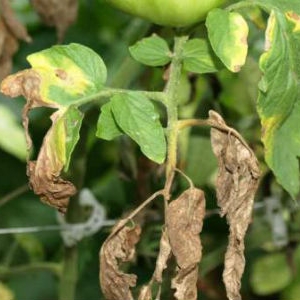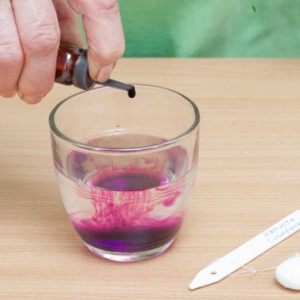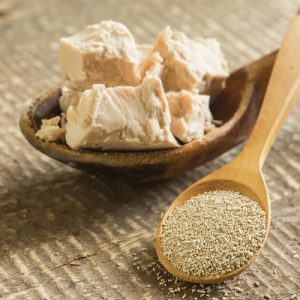How to deal with late blight on tomatoes in a greenhouse using folk methods: the best ways to treat and prevent disease
Noticing the signs of late blight on tomatoes, do not rush to use chemicals. We will tell you what to do if phytophthora appears on tomatoes, how to deal with it with folk remedies in a greenhouse.
In this article, you will find available recipes for solutions against late blight, tested by gardeners on personal experience.
The content of the article
Symptoms and causes of damage to tomatoes by late blight

Phytophthora on tomatoes appears in the second half of summer, causing a disease called late blight... It is a fungal disease that affects nightshade crops.
Leaves, stem, and then fruits are covered with brown spots. The inflorescences do not develop, dry up, and soon the entire plantation disappears.
Fungal spores live in the soil, in the remains of leaves, in garden tools, affecting plants every year.
Among the reasons for the appearance of phytophthora are long-term cultivation of a crop in one place, proximity to other nightshades, excessive humidity, damp weather, frequent fogs, abundant dew and too close planting of tomato bushes.
Folk remedies to combat late blight in the greenhouse
To obtain an environmentally friendly harvest, our grandmothers used folk remedies from late blight on tomatoes.
Hydrogen peroxide
Gardeners love this tool for its qualities:
- enriches plants with oxygen;

- has disinfecting properties;
- increases seed germination;
- saturates the root system with air;
- possesses disinfectant qualities.
Due to the content of hydrogen and oxygen molecules in peroxide, the oxidation process occurs when it enters the soil. From this reaction, the pathogenic spores of phytophthora die.
Application of peroxide solution:
- Soil processing. It is carried out in the spring five days before planting. Pour two liters of solution into the prepared wells. Prepared in the proportion: 6 liters of water - 100 mg of peroxide.
- Disinfection of seeds before planting with 3% peroxide solution. The seeds are kept for 20 minutes, then dried.
- To stimulate the growth of seedlings after planting, every week they are sprayed with a solution: 2 liters of water - 4 tbsp. l. peroxide.
- Adult bushes, cracks, are treated with a foliar and root method with a solution: 2 liters of water, two tbsp. l. drug.
Important... Hydrogen peroxide is diluted in warm water. Tomatoes are processed every week.
Salt
In the garden, it is used as a prophylactic agent in the fight against late blight. Plants after treatment with saline are covered with a thin film, which prevents the spread of phytophthora fungi.
At the first sign of illness, remove damaged leaves and fruits. Then treat the bushes with a salt solution: 10 liters of water, a glass of salt.
Copper wire
The method that gardeners used in the last century: piercing the stem of tomatoes with copper wire. To do this, the wire is calcined, cut into pieces of 3 cm.
The stem is pierced at the base at a distance of 10 cm from the ground. The ends of the wire are lowered without twisting. The plant receives the required amount of copper, which makes tomatoes more resistant to disease.
Attention... Piercing is done when the tomato stalk becomes dense.
Infusion of garlic with potassium permanganate
 Garlic and potassium permanganate used in the garden as an antiseptic, with which they fight fungal diseases of tomatoes.At the same time, the tincture is an effective fertilizer that, getting into the soil, stimulates the release of compounds that feed the plant roots. The tops are developing, the tomatoes look healthy and robust.
Garlic and potassium permanganate used in the garden as an antiseptic, with which they fight fungal diseases of tomatoes.At the same time, the tincture is an effective fertilizer that, getting into the soil, stimulates the release of compounds that feed the plant roots. The tops are developing, the tomatoes look healthy and robust.
Solution properties:
- the product has a disinfecting effect;
- heals cracks in fruits;
- saturates the soil with oxygen molecules;
- destroys fungal spores.
Treatment begins before the formation of the first ovaries, subsequent times are carried out every two weeks.
Preparation of the solution: a glass of chopped garlic is insisted for a day in a bucket of water, then 2 g of potassium permanganate is added.
Yeast
Yeast solution - an excellent remedy for the fight and prevention of late blight on tomatoes. The bacteria found in yeast have a destructive effect on pathogenic fungi, saturating the plant with micro and macro elements.
 Preparation of a solution from dry yeast:
Preparation of a solution from dry yeast:
- we breed a bag of dry yeast in a liter of warm water, the temperature should not exceed 36 degrees;
- add 0.5 liters of old jam or half a glass of sugar;
- mix, pour into a large container and put in a warm place for six hours to ferment;
- dilute the fermented mixture in water up to 10 liters;
- pour a liter of fertilizer under the bush.
We carry out foliar and root top dressing three times per season at intervals of two weeks.
Important! Yeast dressing is used only fresh.
Top dressing with fresh yeast is prepared in the same way as from dry yeast, but take different proportions.
Ingredients:
- serum - 1 l;
- fresh yeast - 100 g;
- iodine - 15 drops;
- water - 9 liters.
Attention... Iodine is added to the solution before spraying.
How to properly spray tomatoes in a greenhouse
Fighting late blight on tomatoes in a greenhouse using folk remedies requires knowledge of agricultural technology.
All fertilizers are applied only after watering in the evening.
In order not to harm the plants and get a crop, you must follow the rules:
- Air the greenhouse in the morning until eight o'clock.
- Remove and destroy diseased leaves and fruits.
- Spray the plants along with the stem and stalk.
- Maintain the proportions in the preparation of the solution.
Preventive measures
Prevention of late blight on tomatoes in a greenhouse folk remedies are carried out immediately after planting the seedlings.
Prevention methods:
- spray tomatoes with 1% potassium permanganate solution twice a season;
- remove old leaves, fallen fruits;
- do not allow the soil to dry out;
- observe the humidity regime in the greenhouse;
- keep the air temperature 22-24 degrees;
- monitor the abundance of lighting;
- apply peat fertilizers;
- watering only at the root;
- remove the top layer of the earth in the fall;
- plant seeds that are not infected with late blight.
Reviews of summer residents
Let's see what summer residents say about the fight against late blight.
Oleg: «My parents used only folk remedies for the prevention of tomatoes from late blight in the greenhouse. I adopted from them such methods of struggle: saline solution, tincture of garlic with potassium permanganate. Her favorite remedy is hydrogen peroxide, tomatoes grow quickly after processing, the greens are bright, actively bloom and bear fruit. "
Natalia: “I fight late blight in the greenhouse only using folk methods. At the beginning of the season, I cultivate the land with a 1% solution of potassium permanganate. After planting seedlings, I switch to hydrogen peroxide. I spray and water every two weeks. I make the solution in the proportion: 2 tbsp. l. peroxide, liter of water. Twice a season I treat it with a solution of iodine with potassium permanganate, I try to water the whole bush.
Fedor: “I decided to grow tomatoes for sale. I learned from a neighbor how to deal with late blight on tomatoes in a greenhouse using folk methods. He always has a crop, the bushes are green. He advised using yeast feeding. Tomatoes grow by leaps and bounds. I cultivate the land in the greenhouse in spring and autumn with a light solution of potassium permanganate. For the prevention of late blight, I feed the tomatoes with hydrogen peroxide at the root. I dilute a tablespoon of peroxide in a liter of warm water.I pour half a liter on the bush. "
Output
Defeating phytophthora on tomatoes in a greenhouse and growing an environmentally friendly product is possible only with biological preparations. They are always at hand or sold in any pharmacy in the city. Using folk remedies in the correct proportions, we will not get poisoned, and our children will not have allergies.